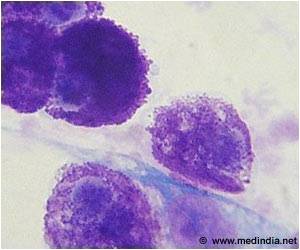A family of microRNAs (miR-200) blocks cancer progression and metastasis by stifling a tumor's ability to weave new blood vessels to support itself.

Subsequent experiments showed for the first time that miR-200 hinders new blood vessel development, or angiogenesis, and does so by targeting cytokines interleukin-8 (IL-8) and CXCL1.
"Nanoparticle delivery of miR-200 blocked new blood vessel development, reduced cancer burden and inhibited metastasis in mouse models of all four cancers," said Anil Sood, M.D., professor of Gynecologic Oncology, senior author of the study.
The team's findings highlight the therapeutic potential of nanoparticle-delivered miR-200 and of IL-8 as a possible biomarker for identifying patients who might benefit from treatment. Sood said safety studies will need to be completed before clinical development can begin.
Micro RNAs do not code for genes like their cousins, the messenger RNAs. They regulate gene activation and expression.
"We initially looked at miR-200 because we have an approach for targeting and delivering these molecules with nanoparticles and miR-200 is known to inhibit EMT, a cellular transition associated with cancer progression and metastasis," said Sood, who also holds the Bettyann Asche Murray Distinguished Professorship in Ovarian Cancer Research.
miR-200 effect differs by breast cancer type
However, they found a striking difference when they analyzed breast cancers by those that are hormone-receptor positive (luminal) and those that lack hormone receptors or the HER2 protein, called triple-negative breast cancer. High expression for miR-200 was associated with improved survival for triple-negative disease, which is more difficult to treat due to its lack of therapeutic targets.
Gene expression analysis of ovarian and lung cancer cell lines pointed to an angiogenesis network involving both IL-8 and CXCL1. By mining public miRNA and messenger RNA databases, the researchers found:
- An inverse relationship between expression of four of the five members of the miR-200 family and IL-8.
- Lung, ovarian, kidney and triple-negative breast cancer all have elevated IL-8 and CXCL1 expression compared to hormone-positive breast cancers.
- Elevated IL-8 associated with poor overall survival in lung, ovarian, renal and triple-negative breast cancer cases.
Treating cancer cell lines with miR-200 decreased levels of IL-8 and CXCL1, and the team also identified binding sites for these genes, meaning they are direct miR-200 targets.
miR-200 nanoparticles stymie metastasis In mouse models of lung and triple-negative breast cancers prone to spread to other organs, treatment with the miR-200 nanoliposomes significantly reduced the volume of the primary tumor and the number and size of metastases in other organs compared to controls. Similar results were observed in an ovarian cancer model, accompanied by sharp reductions in IL-8 levels and blood vessel formation.
Additional experiments showed that these therapeutic effects were due to blocking of IL-8 levels by miR-200. In tumors that had high amounts of synthetically produced IL-8 (designed so that miR-200 could not block it) the cancer burden was no longer reduced. Circulating IL-8 levels in the blood strongly correlated with tumor burden, Pecot said, suggesting it may serve as a possible biomarker for miR-200 treatment.
Treatment of blood vessels cuts metastases by 92 percent
The team then used a chitosan nanoparticle – derived from chitin in the shells of crustaceans – to deliver miR-200 straight to blood vessels. Combination delivery of two types of miR-200 reduced ovarian cancer metastases by 92 percent over controls.Targeting a second ovarian cancer line with the chitosan nanoparticles also developed by Sood and colleagues, resulted in decreased primary and metastatic tumor burden and reduced blood vessel formation with no apparent toxicity observed in treated mice.
Source-Eurekalert
 MEDINDIA
MEDINDIA




 Email
Email










